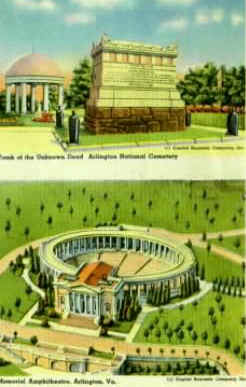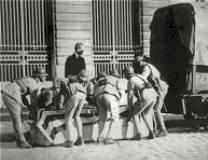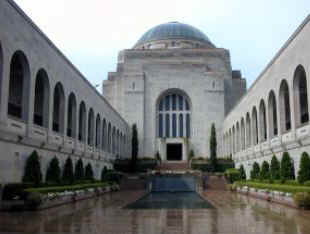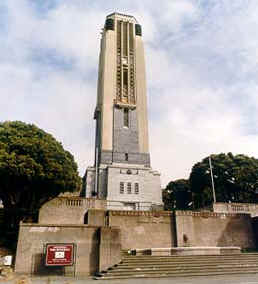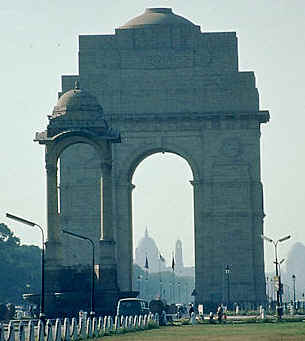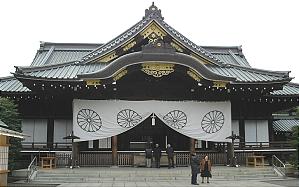|
Usa - Stati Uniti |
|||
ARLINGTON NATIONAL CEMETERYHERE RESTS IN HONORED GLORY AN AMERICAN SOLDIER KNOWN BUT TO GOD
|
Monumento al Milite Ignoto della
1a e 2a Guerra Mondiale al Cimitero Nazionale di Arlington (VA) Il 4 marzo 1921 il Congresso degli Stati Uniti approvava l’inumazione di un proprio soldato sconosciuto, caduto nella Grande Guerra Europea, nell’anfiteatro del nuovo Memorial ad Arlington in Virginia. Il cubo di marmo ha agli angoli quattro colonne classiche e nella faccia che guarda Washington vi sono scolpite figure greche che rappresentano la Pace, la Vittoria e il Valore. Inscribed on the back of the Tomb are the words: The six wreaths carved into the tomb represent six major battles of World War I: Chateau-Terrie, the Ardennes, Oisiu-Eisue, Meuse-Argonne, Belleauwood and the Somme. |
||
|
|
The Unknowns of World War II and Korea
Two unknowns from World War II, one from the European Theater and one from the Pacific Theater, were placed in identical caskets and taken aboard the USS Canberra, a guided-missile cruiser resting off the Virginia capes. Navy Hospitalman 1st Class William R. Charette, then the Navy's only active-duty Medal of Honor recipient, selected the Unknown Soldier of World War II.
furono riesumati dal cimitero nazionale delle Hawaii. Il sergente Ned Lyle si occupò della selezione. I corpi arrivarono a
Washington (D.C) il 28 maggio 1958 e qui restarono nell’atrio del Campidoglio per 3 giorni. Il mattino del 30, dopo che il Presidente li aveva decorati della Medaglia del Congresso, avveniva la sepoltura a poca distanza dal compagno della Grande Guerra.
Ogni guerra ha il suo milite ignoto e il Vietnam in anni successivi non
sfuggì a questo. Nel 1998 il caduto del Vietnam veniva riesumato e identificato coi nuovi sistemi di riconoscimento a mezzo Dna. Si scopriva allora che era il tenente Michael Blassie, pilota di elicotteri caduto
a Xóm An Lôc nel 1972. I parenti ritirarono il feretro e il Pentagono
decise che
non ci sarebbero più stati, militi ignoti o soldati sconosciuti,
quello era l'ultimo. http://www.eyewitnesstohistory.com/unknown.htm TRASLAZIONE DEI CADUTI DALL'EUROPA>>>>> |
||
|
Australia e Nuova Zelanda |
|||
|
NATIONAL WAR MEMORIAL Canberra Australia |
From the Australian Parliament House on Canberra’s Capital Hill, look northeast just beyond Lake Burley Griffin and you’ll see a wide avenue running along your line of vision and ending at a distinctive-looking building with a domed roof at the foot of Mt Ainslie. The building, a stylised Byzantine structure, is the Australian War Memorial. It is a shrine to those Australians who fought for their country, more than 102,000 dying in various conflicts, many on foreign soil. |
||
|
|
The Australian-American Memorial in the heart of the defence complex at Russell Hill commemorates the United States' contribution towards Australia's defence in World War II. The Captain Cook Memorial near Regatta Point marks the bicentenary of the discovery of Australia's east
coast. Eighty years ago Canberra did not exist. Today it is a beautiful city, befitting the capital of a young and prosperous Australia. The site of the city has been enhanced by the planting of more than twelve million trees, by the creation of its attractive lakes, by fine buildings and careful planning. C.E.W. Bean first began thinking about commemorating the sacrifice of Australians in war in 1915, at Gallipoli. L’idea di un museo nazionale gli venne però dopo aver visitato i campi di battaglia francesi della Grande Guerra dove gli australiani ebbero 23.000 morti in sole 7 settimane nel 1916. La distanza e l’impossibilità degli australiani di venir a piangere i propri morti in Europa lo convinse a costruire a Canberra, nuova Capitale d’Australia, il Sacrario dei caduti.. |
||
|
The Hall of Memories Wellington Nuova Zelanda |
 Il New Zealand's National War memorial è composto dalla torre del Carrilon e dal Famedio o Hall of
Memories. Qui si commemorano i caduti d’Africa (Sud Guerra Boera), della grande Guerra, del secondo conflitto, di Corea e del Vietnam. The Hall of Memories is approached through an octagonal vestibule forming the base of the Carillon Tower. Inside, there are six memorial alcoves on each side leading up to an apse and Sanctuary at the southern end of the
Hall. Le cappelle sono dedicate alle differenti armi dell’Esercito. Il New Zealand's National War memorial è composto dalla torre del Carrilon e dal Famedio o Hall of
Memories. Qui si commemorano i caduti d’Africa (Sud Guerra Boera), della grande Guerra, del secondo conflitto, di Corea e del Vietnam. The Hall of Memories is approached through an octagonal vestibule forming the base of the Carillon Tower. Inside, there are six memorial alcoves on each side leading up to an apse and Sanctuary at the southern end of the
Hall. Le cappelle sono dedicate alle differenti armi dell’Esercito. |
||
|
|
Tomb of the N.Z Unknown Soldier Consisting of a Carillon constructed in 1932, and a Hall of Memories completed 32 years later, the National War Memorial is a solemn tribute to, and a commemoration of, the contribution of all those New Zealanders who have served and died in war. In 1919, after the end of the First World War, the New Zealand Government unanimously approved the expenditure of £100,000 to construct from permanent materials, a highly visible National Memorial that would embody the objects and sacrifices of war. After considerable debate, the prominent Mount Cook site in Wellington was selected in 1928. Long associated with war, the site was used as a pa by Te Ati Awa and for military purposes by the Government from 1847. Debate over the form that the memorial was to take was partially resolved in 1927 by the Wellington War Memorial Carillon Society, who gifted 49 bronze bells to the Government. Originally intended to form part of the Wellington war memorial, the bells were paid for by the public and inscribed with the names of the donors and the city's war dead. Shortly afterwards the Government concluded that the National War Memorial should consist of two structures; a carillon, in which the bronze bells would be housed, and a 'hall of memories'. A new national museum and art gallery building was to be constructed to the rear of the memorial. |
||
|
Canada |
|||
|
National War Memorial Ottawa "A Canadian Soldier—Known Unto God." |
The National War Memorial stands majestically in Confederation Square in the heart of downtown Ottawa with the Parliament Buildings and the distant Gatineau Hills in the background. Rising 21 metres from its base, the memorial consists of an arch of granite surmounted by emblematic bronze figures of Peace and Freedom. Shown advancing through the archway are 22 bronze figures symbolic of the "Great Response" of the hundreds of thousands of Canadians who answered the call to serve. |
||
|
|
Il National War Memorial
era stato progettato per ospitare 60.000 canadesi che lasciarono la vita nei campi d’Europa nella Grande Guerra. Da allora è stato allargato* per ospitarne altrettanti dai conflitti successivi. Il monumento è composto da 22 soldati che attraversano l’arco della Pace e della Libertà. *The years "1939-1945" and "1950-1953" were added (nel 1982) to the memorial to honor those who died the World War II and the Korean War. The remains of an unknown Canadian soldier (WWII) were brought from France (Vilmy) to Ottawa and buried in front of the National War Memorial (nel 2000). http://www.virtualmemorial.gc.ca/ http://collections.ic.gc.ca/courage/index.html
India |
||
|
India Gate - New Delhi |
This landmark was designed to honour the 70,000 Indian soldiers who lost their lives in the First World War. Another additional 13,516 names engraved on the arch and foundations form a separate memorial to the British and Indian soldiers killed on the North-West Frontier in the Afghan War of 1919. |
||
|
|
The foundation stone was laid by HRH the Duke of Connaught in 1921 and the monument was dedicated to the nation 10 years later by the then
Viceroy, Lord Irwin. Another memorial, Amar Jawan Jyoti was added much later after India had said goodbye to its imperial rulers.
Situated on the Rajpath, New Delhi, India Gate i.e. originally called All India War Memorial was built by Edwin Lutyens.
I nomi dei soldati sono iscritti sulle pareti. Sotto l’arco brucia, dal 1971, la fiamma Amar Jawan Jyoti (eternal soldier's flame) del soldato ignoto. L’India gate (arco) è alto 39,6 metri e largo 27,4. Ogni mattone,ogni blocco, racconta la storia dei suoi reggimenti e dei suoi eroi. Il lungo viale costeggia il palazzo del Viceré.
Photograph © Medha Malik Kudaisya -- may be used without prior permission for any educational or scholarly purpose. |
||
|
Giappone
|
The shrine was founded in 1869 as Tokyo Shokonsha, and was renamed Yasukuni Shrine in 1879 | ||
|
|
YASUKUNI JINJA IL TEMPIO DELL'ONORE It was build in order to commemorate and worship those who have died in war for their country and sacrificed their lives to help build the fundament for a peaceful Japan (the meaning of Yasukuni is "peaceful country"). The deities of about 2.5 million people who died for Japan in the conflicts accompanying the Meiji Restoration, the Satsuma Rebellion and similar domestic conflicts, the First Sino-Japanese War, the Russo-Japanese War, the First World War, the Manchurian Incident, the Second Sino-Japanese War and the Pacific War are enshrined at Yasukuni Shrine in form of mortuary tablets with inscribed names. The Yushukan, a museum commemorating Japan's wars is located just next to the shrine's main buildings. |
||

